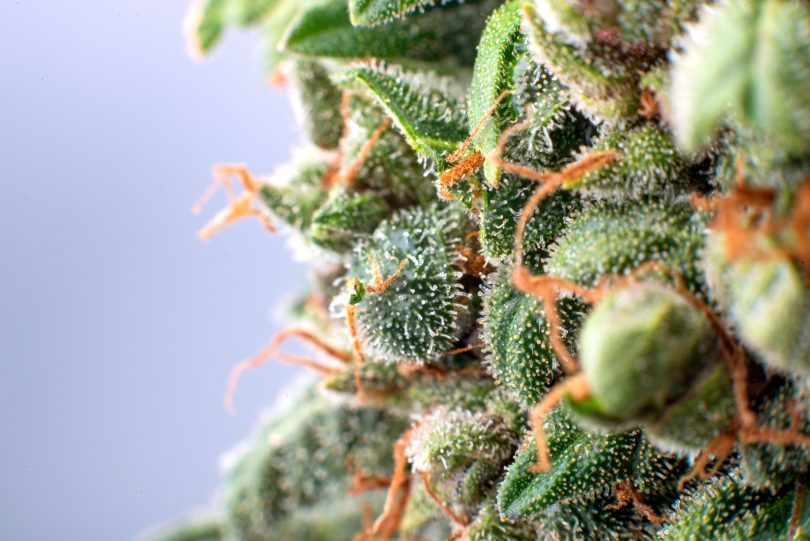Terpenes are a diverse group of organic compounds found in many different types of plants; from flowers to fruits and vegetables. Terpenes have many of their own functions in nature, such as encouraging pollination and deterring certain animals, but they’re also known to be extremely beneficial for human health.
Our relationship with plants dates back to the beginning of time. Humans have been using plants to satisfy many different basic needs. Trees provide shelter and shade, fruits and vegetables offer sustenance, plant stalks make clothing, and herbs and flowers can be used medicinally. There are numerous different compounds in plants that have therapeutic value, but most people don’t realize that terpenes, the molecules that give plants their distinct aromas and flavors, are a huge part of this equation.
Enter cannabis, a plant that can be used to treat an extremely large range of varied conditions, and it’s loaded with terps. Many very common terpenes, like limonene and pinene – found in citrus fruits and pine trees respectively – are also found in cannabis. Both hemp and marijuana plants have numerous different terpenes, despite the differences in cannabinoid content.
A very common but often overlooked terpene is Caryophyllene. If you look at COAs (certificate of analysis) when shopping for flower, you’ll notice this terp is found in many of this year’s most popular strains. What is it exactly? How does it taste? And most importantly, what are the benefits?
To learn more about cannabis, use the form below to subscribe to the Medical Cannabis Weekly Newsletter
What is Caryophyllene? The Biology Behind the Terp
Beta-caryophyllene, more commonly referred to as just Caryophyllene, is part of a class of terpenes knowns as sesquiterpenes, which are basically just terpenes with a unique molecular structure. It’s biosynthesized from two common terpene precursors: dimethylallyl pyrophosphate (DMAPP) and isopentenyl pyrophosphate (IPP). Caryophyllene is a relatively large molecule, notable for having a cyclobutane ring, as well as a trans-double bond in a 9-membered ring, both characteristics being biological rarities.
Caryophyllene’s main distinction is that it’s the first known dietary cannabinoid, meaning the FDA has it listed as being generally safe for human consumption. It’s also one of the first known, non-cannabinoid compounds that binds directly to the Endocannabinoid receptors of the human body. Caryophyllene is found in many different types of food items, mainly spices. It has a pale-yellow color and a spicy flavor. It’s the main terp found in pepper, cloves, allspice, and so on.
Although it’s not as popular as other terps, like limonene, caryophyllene is one of most thoroughly researched terpenes found in cannabis. Organic chemist and Harvard researcher, E. J. Corey, began studying caryophyllene back in the 1960s and was able to demonstrate many potential uses for this compound over the years.
Caryophyllene and the Endocannabinoid System
To quickly recap on the Endocannabinoid System, it’s a vast and intricate network of receptors found in bodies of all mammals. So far, researchers have been able to identify two different endocannabinoids: 2-arachidonoylglycerol (2-AG) and anandamide (AEA), as well as two main receptors: CB1 and CB2. CB1 receptors are found throughout the brain and central nervous system and CB2 receptors are located primarily in our peripheral organs. In short, the Endocannabinoid system is responsible for maintaining homeostasis – or balance.

Caryophyllene’s molecular structure allows it to bind to CB2 receptors, meaning it activates receptors in numerous different tissues such as the spleen, white blood cells, endocrine gland and parts of the reproductive, gastrointestinal and urinary tracts. It’s actually the only terpene known to directly interact with CB receptors so far.
Its effects on the endocannabinoid system make it a very potent antioxidant and anti-inflammatory.
Medical Benefits of Caryophyllene
As far as cannabis compounds go, caryophyllene is one that has a bit more research to back up the medical claims. This is because caryophyllene is also found in so many different food products, so it’s been studied more extensively from a nutritional standpoint.
Studies indicate numerous possible uses for this terpene. In 2014, a study found that caryophyllene reduced pain response in rodent subjects. Another study from that same year discovered that caryophyllene can be used to reduce alcohol intake, and possibly dependence other addictive substances. Caryophyllene is also believed to have antioxidant and anti-inflammatory properties, making it a suitable treatment option for treating inflammatory bowel disease. Research has found that caryophyllene may also be able to reduce anxiety and depression.
Another very interesting theory is that caryophyllene can even make you live longer. Not via the obvious routes, like its application in the treatment of certain diseases and conditions, but by actually reducing gene stress and making you “younger” on a cellular level.
Caryophyllene’s Unique Flavor Profile
Since caryophyllene is present in herbs such as black pepper, basil, oregano, and cloves, you can get an idea of the flavor this terpene would have when isolated. It has a spicy, warm, somewhat sweet taste that’s founds in many popular strains on the market today.

Cannabis has numerous different terpenes in it, and as such, you’ll never get a bud that tastes like straight pepper or cinnamon. Usually, it’s combined with other terps like limonene and myrcene, so interestingly enough, you’ll notice a gassy, fuel, diesel-like flavor in many of these flowers.
Some popular strains with the gas flavor that have an abundance of the caryophyllene terpene include Chemdawg, Sour Diesel, and Legendary OG, the latter being a CBD-dominant hemp flower strain.
Where to find Caryophyllene in Nature
The following plants are very high in the caryophyllene terpene:
- Cannabis (Cannabis sativa)
- Black caraway (Carum nigrum)
- Cloves (Syzygium aromaticum)
- Hops (Humulus lupulus)
- Basil (Ocimum spp.)
- Oregano (Origanum vulgare)
- Black pepper (Piper nigrum)
- Lavender (Lavandula angustifolia)
- Rosemary (Rosmarinus officinalis)
- True cinnamon (Cinnamomum zeylanicum)
- Malabathrum (Cinnamomum tamala)
- Ylang-ylang (Cananga odorata)
- Copaiba oil (Copaifera)
Many other plants, like figs for example, have minimal amounts of caryophyllene as well.
What Cannabis Strains are High in Caryophyllene?
Some strains with a higher-than-average amount of caryophyllene include:
- Girl Scout Cookies/GSC (marijuana)
- Bubba Kush (marijuana)
- Sour Diesel (marijuana and hemp)
- Chemdawg (marijuana and hemp)
- Candyland (marijuana)
- Death Star (marijuana)
- Original Glue Cookies (marijuana)
- Cream Gelato (marijuana)
- White Master Kush (marijuana)
- Legendary OG (hemp)
For reference, marijuana is the type of cannabis that has MORE than 0.3% THC, and hemp is the type of cannabis that has LESS than 0.3% THC.
Final Thoughts
Normally I end these articles hoping that more research is done on whatever topic I’m writing about, since official studies are so lacking in the cannabis sector. Luckily, there is quite a bit to work with when examining the caryophyllene terpene and all of its many, interesting benefits.
Thanks for stopping by CBD TESTERS, your hub for all things cannabis-related. Stop by regularly and make sure to subscribe to the Medical Cannabis Weekly Newsletter to keep up-to-date on all the most interesting industry topics.







